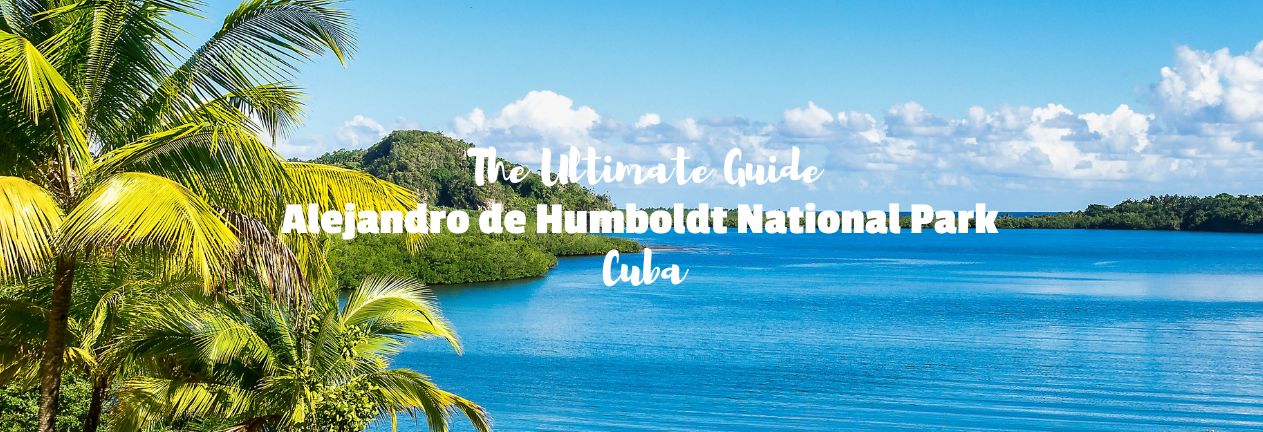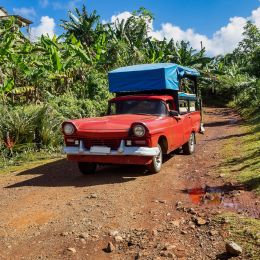This national park spans the provinces of Holguin and Guantanamo and is in Cuba’s East – el Oriente. The Alexander Humboldt National Park sits within the Cuchillas del Toa Biosphere Reserve and is home to 16 of Cuba’s 28 endemic species of plants, special species of parrot, hutia, and snail. It is a glorious eco-tourism resource that can be visited most easily from Baracoa. Here’s what you need to know about visiting Alejandro de Humboldt National Park – from how to get here, what to see, and what you’ll need to take with you.
THIS POST MAY CONTAIN COMPENSATED AND AFFILIATE LINKS. MORE INFORMATION IN OUR DISCLAIMER
This is the place in Cuba where you’ll see the most diverse plant life forms and landscapes. The park includes primary forests, mangroves, caves, rivers, streams, and waterfalls. It also includes agricultural land.
EASIEST WAY TO TRAVEL
The easiest way to visit Alejandro de Humboldt National Park is from Baracoa – you can prebook a trip with Civitatis. This prepays and includes your transport and a guide, and an 8-hour day trip. The guide speaks Spanish, English, and French, too!
Why Visit Alejandro de Humboldt National Park
If you’ve made it all the way here to Baracoa, then you should make the most of your visit. The Alejandro de Humboldt National Park is unique. The landscapes and seascapes it incorporates, the plant and animal life it protects, make it one of the most important eco-resources in the Caribbean, not just Cuba.
The park covers 275 square miles, of which about 9 square miles are in the sea. Across the mountains, rivers, forests, lagoons, and mangroves that the park includes, there are more than 145 types of ferns, 20 species of amphibians, and more than 1,000 flowering plants. The rock underneath the soil here is unique in its toxicity, and means that everything has been forced to adapt. It is rich in endemic plants, animals, and marine life.
Add to all that the fact that it’s beautiful, and you have a whole lot of reasons to visit Alejandro de Humboldt National Park from Baracoa.
PRACTICAL TRAVEL TIPS
- 🛡️ Get Travel Insurance: Civitatis includes medical expenses, repatriation, theft, luggage delays. No deductibles or upfront payments. Get a quote here. .
- 🛂💻 Buy your Cuba eVisa here.
- 🔌 Be ready for the plug, socket & power situation.
- 📶 Internet, maps, data on the go. Buy an eSim for Cuba. Or pre-order a physical SIM card
- 🔒 Do NOT leave home without a VPN. Buy for your trip here.
Where is Alejandro de Humboldt National Park?
Alejandro de Humboldt National Park is 25 miles (40 kilometers) to the northwest of Baracoa. It takes about an hour to drive to the park from Baracoa. The park is found within the Nipe-Sagua-Baracoa Mountains.
How to Get to Alejandro de Humboldt National Park
There are no public buses or public transport links to Alejandro de Humboldt National Park. You will need to take a taxi, pre-arrange a transfer or tour, or drive there yourself.
If you plan on driving, then read my guide to rental cars in Cuba here. You will still need to engage a guide when you arrive at the park.
Occasionally, Gaviota and Cubatur tourist agencies will offer day trips to Alejandro de Humboldt National Park from Baracoa. Ask at the agencies in town. You’re likely to get much more out of your trip by taking a private taxi or transfer. Ask your casa particular owner to arrange a taxi for you (approximately US$40 for the round trip). This rate does NOT include a guide, and you will have to engage one at the park.
If you include transport and a guide, and entrance at the park, expect to pay a total of around US$55 per person for the visit.
Alternatively, prebook a guided tour that includes your transport, a guide, and the itinerary that you’ll find here.
What to See and Do at the Alejandro de Humboldt National Park
There are four different hiking trails here at the Alejandro de Humboldt Park, from the El Recreo trail, which is a moderate 2-mile (3 km) trek and provides a walk along Taco Bay. There’s another trail of about the same length that goes to the El Copal waterfall and provides stunning views of the park. The third hike is 4.5 miles (7 kilometers) long and is named the Balcón de Iberia trail. It’s a bit tougher and gives you access to more of the landscapes of the park, culminating with the Salto de Agua Maya waterfall. The final hike will take around 8 hours and head into the primary forest within the park to take an in-depth look at the flora and fauna of the park.
It’s also possible to take a tour of the mangrove forest on a motorboat and then take a hike. Ask locally if you’re not on a guided tour from Baracoa.
It’s in this park that you’ll get the opportunity to spot some of Cuba’s 16 endemic species of plants that are present here. You may also see parrot, snail, hummingbird, and hutia (the rodents after which Cayo Jutias in the west is named).
Tours from Baracoa include the chance to have lunch, chill out on the glorious Maguana Beach, and swim in the Recreo River. There’s more on this visit to Parque Nacional Alejandro Humboldt, including booking details here.
Important information for visiting Alejandro de Humboldt National Park
The park is named after Alexander von Humboldt, a German scientist who visited here in 1800 and 1801. He spent a year studying the animal and plant species here. There was hardly any use of the land included in the park until the 1960s, when it was first protected as a nature reserve. Roll forward to 2001, and UNESCO declared it “one of the most biologically diverse tropical island sites on earth” by UNESCO, and it became one of Cuba’s UNESCO World Heritage Sites.
The Alejandro de Humboldt National Park gets the most rain of anywhere in Cuba, which leads to some of its diversity, as do the landscapes. It goes from sea level to almost 3,832 feet (1,168 meters) at the top of El Toledo. It is one of 14 National Parks in Cuba (my guide to the others is here).
Who was Alejandro de Humboldt ?
The park is named after Alexander von Humboldt, a German scientist who visited here in 1800 and 1801. He spent a year studying the animal and plant species here. Often considered the “second discoverer” of Cuba, Humboldt believed that there was huge commercial and agricultural potential for Cuba; he based this on his thorough sociological, botanical, and geographical research.
Entrance Fees to the Alejandro de Humboldt National Park
There’s an entrance fee to Alexander Humboldt National Park. It costs between 5 and 10 CUC to enter, depending on which trails you choose to utilise. Guides are mandatory and generally come from the local communities.
What else to see around Baracoa
There’s a wealth of natural beauty to see here. Here are my recommendations on what to see and visit when you’re in Baracoa.
El Yunque National Park: My guide to the park is here. Book a day trip to El Yunque here.
Boca de Yumuri: My guide to Boca de Yumuri is here. Book a day trip to Boca de Yumuri here.
Maguna Beach: Book a transfer to Maguna Beach here.
The River Miel: Book a day trip to the River Miel here.
CUBA TRAVEL RESOURCES
CUBA BY BUS EBOOK
Buy our Ebook. Preplanned itineraries, themed routes, exact instructions for an easy visit.
Buy Cuba by Bus
BEST
CASA PARTICULARS
See choices here
Luxury rooms? Budget rooms? Laundry? Best room choice & Great hosts.
TOURS & ATTRACTIONS
Top daytrips, small group tours, tickets, pay online easily with free cancellation and top local guides.
Top options here.
TRANSFERS & TAXIS
Read my Guide
Go from A to B easily. Sightsee along the way. Maximise your time in Cuba. Book early for more options.
xxxx BLOCK
Final Words on Alejandro de Humboldt National Park
The UNESCO World Heritage site of Alejandro de Humboldt National Park is a stunning eco-reserve in the east of Cuba. Straddling the provinces of Holguin and Guantanamo, this is a magnificent place to visit, from the peak of El Toledo to the shores of Taco Bay. Don’t miss out when you visit Baracoa.
Cuba’s Best is a participant in the Amazon Services LLC Associates Program, an affiliate advertising program designed to provide a means for sites to earn advertising fees by advertising and linking to amazon.com, amazon.co.uk, amazon.ca. Amazon and the Amazon logo are trademarks of Amazon.com, Inc. or its affiliates.

